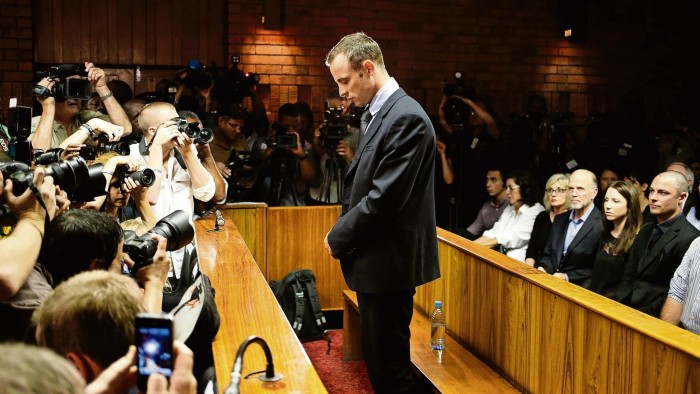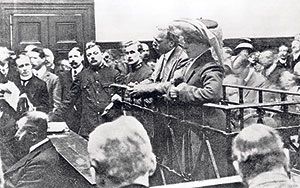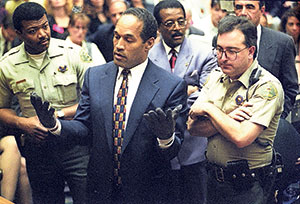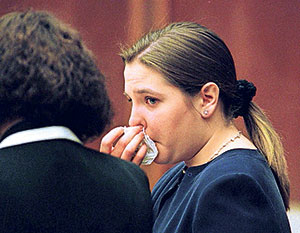The case for televised trials

Simply sign up to the Life & Arts myFT Digest -- delivered directly to your inbox.
The High Court in Pretoria has ruled that Oscar Pistorius’s trial for the murder of his girlfriend, Reeva Steenkamp, set to start on Monday, can be broadcast live on television in South Africa, and so around the world.
Not all of the trial, just the lawyers’ speeches, expert testimony, court rulings and judgments, including, if it comes to it, sentencing. This leaves out what might be the most interesting part of the whole grisly but fascinating business – the evidence, if he gives it, of Oscar Pistorius himself.
So it is not everything but it is something. And it presumably comes as something of a relief to the South African broadcasters who are planning to go to town on the case. Even before the historic ruling to allow the cameras into the courtroom, one of South Africa’s leading cable providers had decided to create a dedicated TV channel to provide round-the-clock coverage of a case that has already attracted huge national and international interest.
With or without TV pictures, the trial will serve up an intoxicating cocktail of celebrity and tragedy, guns and glamour in a courtroom drama more or less guaranteed to outdo anything in the world of fiction. With or without TV pictures, millions of people will be anxious to fathom how a world-renowned athlete came to kill his beautiful model girlfriend in their own home, in the middle of the night, whether by accident or design.
It would certainly be without TV pictures if the trial were taking place in England. English courts have never allowed cameras to show criminal trials in progress. The Criminal Justice Act 1925 made it an offence to take any photograph in court. The act was passed in response to unauthorised snaps being taken of several high-profile defendants in the dock at the Old Bailey. They included the infamous Dr Crippen, George Joseph Smith, the “brides in the bath murderer”, and, most dramatically, the poisoner Frederick Seddon, who was pictured – judge in black cap and all – just as he was being sentenced to death. The ban was also extended to film and, in due course, TV pictures. It even forbids doing a drawing in court, which is why sketch artists have to leave the courtroom before putting charcoal to paper to produce their approximations of the lawyers and litigants involved.

Last year’s Crime and Courts Act amended the law to allow for the introduction of TV cameras in court but so far they have only been allowed to cover appeal courts, judicial pronouncements and the like, not the cut and thrust of an actual hearing in a jury trial, which is likely to attract higher viewing figures but so far remains a no-go area. Scottish courts, subject to different legislation, have on occasion allowed the cameras to film criminal trials.
But, in England, if a witness breaks down under cross-examination, or the accused’s expression betrays his emotions, or a particular answer causes a stir in the courtroom, we still have to hear about it indirectly, like offstage events in a Greek tragedy, from a reporter shouting above the traffic in the street outside the courthouse.
Of course, we can follow the progress of court cases through newspaper reports. In fact, in a modernising move by the Lord Chief Justice that followed reporters tweeting from a bail hearing for WikiLeaks founder Julian Assange in 2010, journalists are allowed to tweet directly from the courtroom. So why not put TV on the same footing? Why not follow the lead of many overseas jurisdictions and allow court cases to be televised?
It is argued that TV cameras might distort the legal process, and witnesses might find being filmed adds to their stress in giving evidence. But if courts and witnesses can cope in other countries, should we not trust ours to cope equally well?
I think we should. I have practised as a barrister and a broadcaster and combine the two in presenting a programme on BBC Radio 4 called Unreliable Evidence. Each week I discuss some aspect of the law with a selection of judges and other eminent lawyers. Occasionally the programme returns to the same topic: usually, we note that the law has developed but sometimes we discover it is stuck in its old ways.
In our first series in 1997 we covered the issue of televising court cases. We discussed it again in 2012. On both occasions I was acting as an impartial BBC presenter, so explored both sides of the argument, but the first time around I can recall thinking that TV coverage was neither needed nor particularly desirable. Watch Friends, not my learned friends.
But today I am a convert to the idea of opening up the courts to the cameras. As one, admittedly rather poor, Lord Chief Justice famously declaimed in 1924, it “is of fundamental importance, that justice should not only be done, but should manifestly and undoubtedly be seen to be done”. Television is manifestly a good way to let people see justice being done, or in some cases not done at all.
…
In fact, I think I started changing my mind during that first discussion. One of the experts was lawyer and legal commentator Fenton Bresler. He was strongly against letting cameras into British courts, even though he had been happy to appear regularly on Court TV in the US commentating on the OJ Simpson trial in 1995.
He argued that televising a court case risks turning it into a media circus, the prime example being the OJ Simpson trial itself, which, most people agree, completely lost its dignity in the glare of worldwide TV coverage. Judge Lance Ito, the presiding judge, was extensively mocked on comedy and talk shows as he seemed to lose control of the high-powered attorneys on either side of the case. But the high-powered attorneys would have caused the judge problems whether the cameras were there or not.

So was it a circus because it was on television or was it on television because it was a circus?
The Michael Jackson case in 2005 was also overwhelmed by hype and hysteria but the trial itself was not televised. Sky television was reduced to restaging the case as it went along, using actors to recreate the day’s proceedings. A perfect example of an unhappy compromise.
Simpson and Jackson were famous before they were accused of a crime and their trials were always going to attract publicity. But some defendants have worldwide fame thrust upon them. And opening up justice can do more than create notoriety.
Louise Woodward’s trial in Boston, Massachusetts, was televised in 1997. Woodward was a 19-year-old English nanny, convicted of second degree murder, in due course reduced to involuntary manslaughter. The deceased was the eight-month-old child she was employed to look after but who died because of injuries alleged to have been caused by her mistreatment.
The case turned in part on what Woodward had meant when she remarked, “I popped him on the bed”, which doesn’t sound remotely suspicious in British English, but in a New England courtroom was seized on as an admission of rough treatment.
Because the trial was televised, viewers were able to see for themselves how fair or unfair the proceedings were; how guilty or not guilty she seemed to be. This greatly assisted the campaign to see her released from prison, which developed on both sides of the Atlantic. It was an unhappy case but had Woodward been on trial in Boston, Lincolnshire, her trial wouldn’t have been seen at all, and interest would have been harder to sustain.
There are other reasons we would wish to film a court case. Take two documentaries: the recently restored Nuremberg: Its Lesson for Today (originally completed in 1948) and last year’s Pussy Riot: A Punk Prayer.

Deciding to film the trial of Nazi leaders just after the war was controversial in its day but I suggest we are more than glad, nearly 70 years on, to have the surviving footage of Hermann Göring, Joachim von Ribbentrop, Albert Speer and the rest of them in the dock or in the witness box. It is equally instructive to see how lawyers from the various victorious powers set about presenting the evidence and arguments in the unprecedented circumstances of the case.
As for Pussy Riot, many see as excessive the punishment meted out for their wild protest song provocatively performed in Moscow’s Cathedral of Christ the Saviour in February 2012 but everyone can see the trial that led to their sentence. Footage of it was generally available and much of it is included in the documentary. If the Russians tolerate cameras recording such a politically sensitive and aggressively conducted case, why can’t cameras be allowed into any of our criminal trials?
It is not as though we have no experience of television cameras capturing law in action. In recent years there have been all sorts of British judicial and parliamentary inquiries – Hutton, Chilcot, Leveson – which have been live on TV and viewers have been able to see the great and good, politicians, journalists and celebrities, questioned and cross-examined by lawyers, allowing viewers to come to their own judgment about the quality of the evidence. The sky hasn’t fallen in with the entry of cameras in court.
However, once the same issues become the subject of a regular criminal trial – the phone-hacking case going on at the Old Bailey at the moment, for example – the TV cameras are barred from entry. When the jury finally gives its verdict, we will have little idea how they came to their decision.
If the objection to televised trials is that serious court cases should not be viewed as mere entertainment, it could be argued that seeing real court cases, great or small, would be educational for people not used to going to court. So if and when they are called for jury service, they will understand the system in which they are called to play an important part, and not surprised by what they see. They will not expect lawyers to walk around the courtroom having their objections immediately “sustained” or “overruled” by a gavel-wielding judge, as happens in Hollywood films and TV series. They will not be waiting for a surprise piece of evidence to be produced like a rabbit from a hat towards the end of the case, as so often happens in TV dramas but so seldom happens in real life.
Those who oppose cameras in court worry that barristers and witnesses and even judges might play to the television gallery. Possibly, but there have been no noticeable histrionics in the televised inquiries I have already mentioned.
The same sorts of objections were raised to televising parliament. As a result, allowing in broadcasters was put off year after year. By 1975, parliament got as far as allowing “experimental” radio broadcasts.
In the same way we could start with just radio coverage of court cases, to see how we cope. Radio is less intrusive, though possibly less revealing. The ruling in Pistorius’s case allows for sound-only coverage of the whole case, even parts of the trial the cameras are not going to be allowed to reach. So this will provide an interesting experiment on how radio coverage might work.
Not until 1990 was televising of the House of Commons put on a permanent basis. But Prime Minister’s Question Time has been a popular hit, attracting viewers around the world, however much the Speaker complains about rowdy backbenchers, and all sorts of more measured debates are available to the political obsessive on a dedicated TV channel.
For better or worse, as far as MPs’ behaviour is concerned? I don’t suppose anybody really knows but nobody, I suggest, would wish to take the cameras out of parliament. And nobody, I suggest, would want to take the cameras out of the courtroom once we had all got used to them. I rest my case.
Clive Anderson is a radio and TV presenter and a former barrister
——————————————-
Pistorius and the South African media
‘Many convicted killers do not get such negative coverage’
Media careers are being made and entrenched from the Oscar Pistorius case, writes Rebecca Davis. Some South African journalists live-tweeting the Pistorius bail hearing in February last year saw their number of Twitter followers rise by almost 100,000, virtually overnight. One book has already been published on the case, with at least six more ready to go as soon as the judge’s gavel falls.
Pistorius himself has lain low since his bail hearing but this hasn’t stopped a number of stories being published on the rare occasions he has ventured out. They have invariably portrayed him in a negative light, painting the picture of a callous partyboy still bent on a good time. One such story, carried in sister newspapers Rapport and City Press in June 2013, reported that Pistorius had visited a car dealership to buy a fancy new vehicle while accompanied by a woman they insinuated was a new girlfriend. The Pistorius family complained to the Press Ombudsman that Pistorius had not bought the car, and the woman was a relative. The complaint was upheld.
That story is emblematic of the kind of coverage Pistorius has received since the shooting. Research company Media Tenor SA analysed 105,000 related South African TV news bulletins in 2013 and found, to quote one researcher, that “many convicted killers do not get close to this level of negative coverage”. It also found that while Pistorius was initially compared with other fallen sports heroes, this shifted to comparisons with convicted criminals.
A desire to give the public the right to rely not solely on subjective journalist accounts was cited by Judge Dunstan Mlambo as a reason to allow TV and radio networks to carry live footage of proceedings. But the judge had harsh words for 24-hour channels that might seek to pontificate on Pistorius’s guilt or innocence. “There is only one court that will have the duty to analyse and pass judgment in this matter,” he said. “And that is this one.”
Rebecca Davis is a columnist for the Daily Maverick, a South African online newspaper
Comments